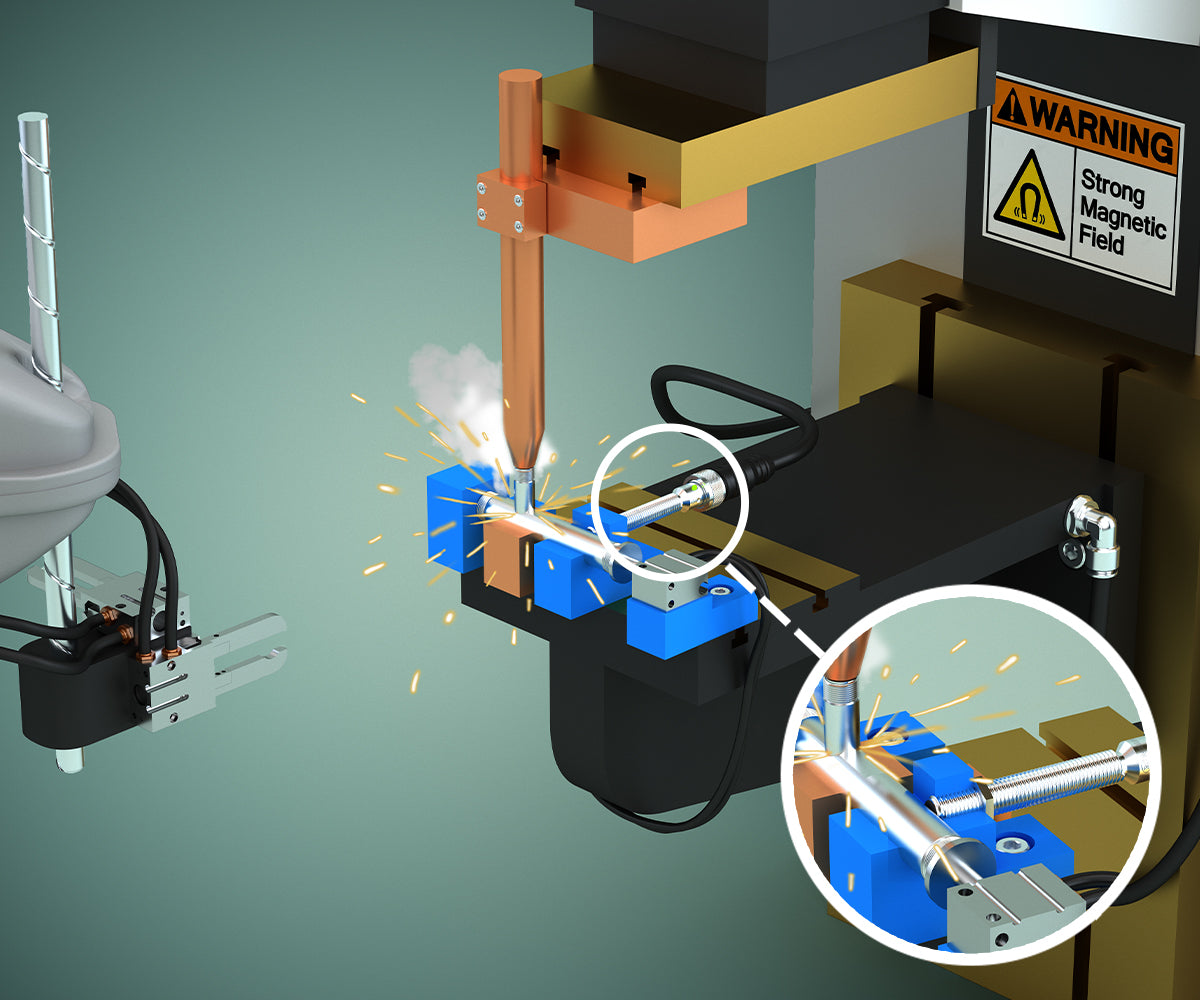Summary
The strong magnetic fields generated by industrial spot welders cause unprotected sensors to malfunction or fail. To prevent misalignment during assembly, a valve manufacturer requires inductive proximity sensors that withstand the exceptionally high currents needed to weld aluminum parts. Contrinex S600 Weld-Immune inductive sensors are immune to electromagnetic interference and sense targets in steel and aluminum equally effectively. Highly reliable and robust, they provide a cost-effective solution with a best-in-class service life.
Customer Application
Resistance welding, widely adopted across industries that includes automotive, aerospace, electronics and white goods, is a sensor killer. The strong magnetic fields generated by spot-welding processes cause unprotected sensors to malfunction or fail, resulting in costly downtime and high maintenance costs.
Industrial designers, who rely heavily on inductive proximity sensors for detection of position and presence in automated process equipment, need devices that withstand the harsh environment of a high-speed welding cell. For sensors located near 50Hz AC-welding equipment, where field strengths may reach 40mT, or medium-frequency (MF) resistance welding, with currents as high as 15 kA, designed-in immunity is essential.
An industrial valve manufacturer, using MF resistance welding to join two aluminum parts, faces an especially demanding challenge. Owing to its lower electrical resistance, aluminum requires welding currents two to three times higher than for steel of equivalent thickness. Inductive sensors that monitor the position of the components prior to welding require proven immunity to high-strength weld-field interference.
Customer Solution
Where sensors are directly exposed to strong electromagnetic fields, designers routinely specify Contrinex Weld-Immune inductive sensors. Sensing aluminum targets during an automated MF resistance-welding process is a task for the Series 600 technology family – not only does the S600 feature Contrinex’s ground-breaking weld-immune technology, it is a true Factor 1 sensor, sensing targets in steel and aluminum equally effectively with no reduction in sensing distance.
In the welding cell, a high-speed robot gripper loads a valve body to the assembly jig, where a small pneumatic cylinder locates it longitudinally. An M8-diameter S600 Weld-Immune sensor, located alongside the lower welding electrode, confirms that the body is correctly positioned and initiates the welding sequence, during which a current of around 15 kA flows through the components being welded. After welding, the assembly is ejected and the process repeats.
The rugged construction of the S600 Weld-Immune technology family includes a metal housing and a temperature-resistant sensing face in a high-strength PEEK polymer; the strong magnetic field from the welding equipment does not affect the sensor’s performance. The M8 sensor has a sensing distance of up to 2 mm, more than adequate for the process. As a true Factor 1 sensor, no correction factor is required for the aluminum target, reducing the chance of an accidental collision during assembly.
For applications directly exposed to weld spatter, sensors are available with an ACTIVSTONE® coating, a high-performance ceramic layer that is especially resistant to weld spatter. All external surfaces of the sensor, including fixing nuts and mounting brackets, are protected, preventing spatter accumulation, while optional spatter-resistant shrouding prevents cable damage.
Ideal for automated welding cells or other environments with high-strength magnetic fields, these highly reliable sensors meet designers’ needs for a robust, low-maintenance solution with a best-in-class service life in exceptionally tough conditions.
Customer Values
- Rugged inductive sensors ensure accurate positioning of aluminum components, eliminating assembly rejects and minimizing downtime
- Weld-Immune sensors provide immunity to electromagnetic interference from 50Hz and medium-frequency weld fields
- Exceptionally high currents needed for welding aluminum do not inhibit accurate detection of targets
- Factor 1 sensors require no reduction in sensing distance for aluminum targets, reducing the chance of accidental collisions
- Proven technology ensures reliable operation with extended service life and minimal down-time
- Optional addition of high-performance ACTIVSTONE® ceramic coating prevents spatter accumulation and inhibits sensor-performance degradation
Specific Product advantages
- Rugged inductive position sensors with one-piece metal housing and robust, temperature-resistant sensing face in a high-strength PEEK polymer
- Weld-Immune sensors combine optimum detection sensitivity with immunity to electromagnetic interference from welding processes
- Factor 1 devices sense targets in steel and aluminum equally effectively with no adjustment in sensing distance
- All external sensor surfaces, including fixing nuts and mounting brackets, can be protected against spatter accumulation with ACTIVSTONE® coating
- Heavy-duty PUR cables with optional spatter-resistant PTFE shrouding prevent cable damage
- Diverse portfolio offers broad range of sizes plus sensing distances up to 8 mm
- Reliable, compact vibration- and shock-resistant sensors
- Industry-standard -25°C to +70°C operating range
